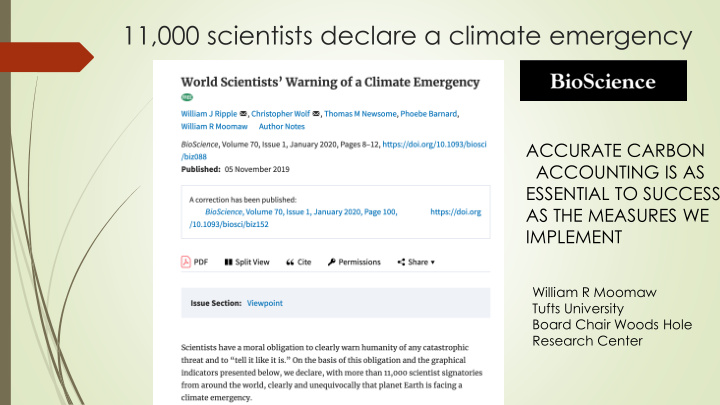



11,000 scientists declare a climate emergency ACCURATE CARBON ACCOUNTING IS AS ESSENTIAL TO SUCCESS AS THE MEASURES WE IMPLEMENT William R Moomaw Tufts University Board Chair Woods Hole Research Center
Global warming is reaching levels at which forests and other natural systems cease to be allies Forest loss to wildfires releases CO 2 & Black Carbon Thawing permafrost releases CO 2 & CH 4
CO 2 ppm Global average warming Urgent action is needed to limit and reverse the growth of heat trapping gases in the atmosphere Solomon et al 2009
Intergovernmental Panel on Climate Change Special Report Global Warming of 1.5 o C October 8, 2018 To keep temperatures from rising excessively “… global net anthropogenic carbon dioxide emissions (must) decline by about 45% from 2010 levels by 2030 … reaching net zero around 2050 …” Must simultaneously reduce combustion emissions and decrease atmospheric carbon dioxide by forest growth immediately. Continue to lower Concentrations below current levels to 350 ppm or lower after 2050 Moomaw 2020
Dynamics of carbon from repeated harvests for lumber or bioenergy Proforestation – Letting forests grow to their ecological capacity to store carbon and reach Tons its biodiversity per potential acre 22 22
Emissions from Carbon from Oregon Harvesting US After 115 years (Hudiburg 2019) 2016 (Harris et al, 2016) Estimates of carbon storage in wood products is overestimated between 2-100-fold (Harmon, 2019)
Direct Emissions from Forest Bioenergy Southeast U.S. harvested for wood Global emissions from forest pellets to replace coal in Europe bioenergy adds 4-5% to global fossil fuel CO 2 emissions Particulate air pollution from bioenergy is especially harmful to human health STOP Subsidizing Forest Bioenergy!
Wetland forests: “Enviva suppliers take extra care by using specialized harvesting equipment and techniques that minimize environmental impacts and protect soil and water quality” http://www.envivabiomass.com/faq-forests-fiber-sourcing/#wetlands Lands in North Carolina harvested to supply wood pellets for Europe
IPCC AR 5 WG 3 11.13.4 GHG emission estimates of bioenergy “The combustion of biomass generates gross GHG emissions roughly equivalent to the combustion of fossil fuels. If bioenergy production is to generate a net reduction in emissions, it must do so by offsetting those emissions through increased net carbon uptake of biota and soils.” “…bioenergy systems have often been assessed under the assumption that CO 2 emitted from combustion is carbon neutral. … The shortcomings of this assumption have been extensively discussed…”
Current Carbon Storage (Aboveground ca. 2016) Walker, et al. In preparation Not for distribution
Potential Carbon Storage (Aboveground) Walker, et al. In preparation Not for distribution
Unrealized Potential Carbon Storage (Aboveground) Walker, et al. In preparation Not for distribution
Strategies for closing the sequestration gap Preventing deforestation and degradation, the draining of wetlands and soil degradation are essential to avoid irreversible and catastrophic climate change before it is too late Proforestation management of more of our forests is among the most effective Let More Grow actions and least costly options for removing and storing additional atmospheric carbon dioxide (Moomaw et al, 2019)
Recommend
More recommend